|
|
|
Sort Order |
|
|
|
Items / Page
|
|
|
|
|
|
|
| Srl | Item |
| 1 |
ID:
154742
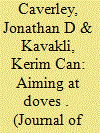

|
|
|
|
|
| Summary/Abstract |
Politicians (and journalists covering them) assume that association with the military has political consequences. We propose and experimentally test conditions under which military images have such effects. We presented subjects with images of the US president before varying backgrounds—including soldiers, students, children, and “ordinary” people. Only the image of soldiers has any significant effect, shifting participant preferences toward spending money on defense over education. The image does this by increasing respondent sense of threats to national security, despite the military’s depiction out of combat and in the background. The soldiers image does little to shift opinion about the president. However, the image has the largest hawkish effect on both the president’s copartisans and the strongest supporters. Given the routine use by many democracies of tactics unlikely to produce images of one’s fellow citizens in combat, the power of more sanitized images to cue hawkish policy preferences requires increased attention.
|
|
|
|
|
|
|
|
|
|
|
|
|
|
|
|
| 2 |
ID:
175512
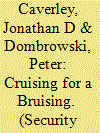

|
|
|
|
|
| Summary/Abstract |
This paper explores the likelihood of maritime crisis stability between China and the United States by building on existing research on the Sino-American naval balance and the concepts of offense–defense theory. Whereas a “denialist” school in security studies argues that counterintervention technology makes defense dominant in the region, the US Navy remains a fleet designed for an offensive approach of power projection and sea control. Although this stubbornness in the face of a sophisticated anti-access capability might be attributable to a strong operational culture and obvious bureaucratic incentives, we posit additional forces suggesting defense dominance will not lead to crisis stability. At sea, offense–defense distinguishability is low and the temptation to strike first is high. Future interaction between current US and Chinese fleet designs risks a crisis or even war that will endanger the US fleet, potentially leading to the loss of the very military advantages underpinning American hegemony that its navy seeks to defend.
|
|
|
|
|
|
|
|
|
|
|
|
|
|
|
|
| 3 |
ID:
101887


|
|
|
|
|
| Publication |
2011.
|
| Summary/Abstract |
Cost distribution theory suggests that the costs to the median voter in a democracy of fighting an insurgency with firepower are relatively low compared to a more labor-intensive approach. Therefore, this voter will favor a capitalintensive counterinsurgency campaign despite the resulting diminished prospects of victory. Primary and secondary sources show that President Lyndon Johnson and his civilian aides were very much aware that, although they considered a main force-focused and firepower-intensive strategy to be largely ineffective against the insurgency in South Vietnam, it was politically more popular in the United States. Importantly, civil-military agreement on warfighting strategy does not undermine this explanation, which assumes that civilian leaders, and ultimately the public, play an essential role in that strategy's determination. Appointing and supporting Gen. William Westmoreland was just one means by which the Johnson administration ensured that the U.S. military emphasized the fight against conventional enemy units and relied on the use of firepower for the fight against Vietcong insurgents. Civil-military disagreements over strategy, however rare, therefore provide the essential test of cost distribution theory's explanatory power. When officials suggested that the U.S. military adopt more labor-intensive pacification approaches to fight the insurgency, the Johnson administration rejected them.
|
|
|
|
|
|
|
|
|
|
|
|
|
|
|
|
| 4 |
ID:
192533
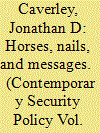

|
|
|
|
|
| Summary/Abstract |
Major arms producing states and defense firms have struggled to supply the Ukraine war's massive demand for munitions. Key elements of the war—such as artificial intelligence-enabled analysis of data obtained from commercial surveillance satellites transmitted by the privately-owned Starlink network—have emerged from new providers as well as developed organically on the battlefield. Research failed to anticipate this due largely to the discipline’s focus on the “defense industry” rather than three distinct “defense industries” highlighted in the war: platforms such as tanks, commodities such as artillery shells and loitering munitions, and militarized “tech” such as commercial satellites and artificial intelligence. Understanding each requires a distinct political economic approach. Using these three lenses, the article concludes that the United States retains advantages in all three industries, Europe risks regressing into a commodities producer, and China seeks to disrupt, rather than duplicate, American defense industrial advantages in technology.
|
|
|
|
|
|
|
|
|
|
|
|
|
|
|
|
| 5 |
ID:
157364
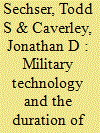

|
|
|
|
|
| Summary/Abstract |
Why do some civil conflicts end quickly, while others last for years? We argue that an incumbent government’s military forces play a crucial role in conflict duration. Specifically, combined arms militaries—which bring to bear a mixture of mechanized infantry, armor, and aircraft—make short conflicts more likely. The use of mechanized ground forces in combination with airpower increases the likelihood of decisive engagements early in a conflict, helping to mitigate information asymmetries that can drive violence. By contrast, less-mechanized forces face greater difficulty bringing the fight to the enemy. Combined arms militaries therefore tend to bring conflicts to more rapid conclusions. However, like maneuver warfare in conventional interstate conflict, these outcomes do not always favor incumbent governments. To test this argument, we employ new, detailed data on military mechanization and airpower from civil conflicts between 1967 and 2003. The results indicate that national militaries with high combined arms capabilities are associated with significantly shorter conflicts. Perhaps surprisingly, this relationship remains robust even when we limit the analysis to insurgencies.
|
|
|
|
|
|
|
|
|
|
|
|
|
|
|
|
| 6 |
ID:
093026
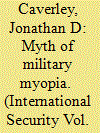

|
|
|
|
|
| Publication |
2009.
|
| Summary/Abstract |
A capital- and firepower-intensive military doctrine is, in general, poorly suited for combating an insurgency. It is therefore puzzling that democracies, particularly the United States, tenaciously pursue such a suboptimal strategy over long periods of time and in successive conflicts. This tendency poses an empirical challenge to the argument that democracies tend to win the conflicts they enter. This apparently nonstrategic behavior results from a condition of moral hazard owing to the shifting of costs away from the average voter. The voter supports the use of a capital-intensive doctrine in conflicts where its effectiveness is low because the decreased likelihood of winning is out-weighed by the lower costs of fighting. This theory better explains the development of the United States' counterinsurgency strategy in Vietnam during Lyndon Johnson's administration compared to the dominant interpretation, which blames the U.S. military's myopic bureaucracy and culture for its counterproductive focus on firepower and conventional warfare.
|
|
|
|
|
|
|
|
|
|
|
|
|
|
|
|
| 7 |
ID:
175509
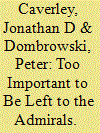

|
|
|
|
|
| Summary/Abstract |
For the first time since World War II the most likely friction points between a rising, potentially revisionist power and a declining, largely status-quo power are located at sea. This special issue accordingly seeks to set an appropriate agenda for security studies research. It presents six interconnected articles exploring different dimensions of maritime competition, largely between China and the United States. Between them, the articles employ three important approaches to security studies: quantitative analysis, pairing classic international relations theory with qualitative evidence, and operational-level research. Together, they consider different geographies—competition and conflict in the Western Pacific versus in the greater Middle East; different issue areas such contending legal claims and control over sea lines of communication; and, finally, different uses of naval power—including blockades, naval diplomacy, fleet engagements, and nuclear escalation. Combined, the issue encourages applying the many classic approaches of security studies to this high-stakes relationship while considering maritime conflict as distinct from other forms, such as land and nuclear, that have traditionally occupied the field.
|
|
|
|
|
|
|
|
|
|
|
|
|
|
|
|
| 8 |
ID:
080506
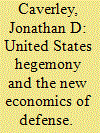

|
|
|
|
|
| Publication |
2007.
|
| Summary/Abstract |
Liberal theory asserts that the need for cost-effective, technologically advanced weapons requires the United States to acquiesce to increasing defense globalization even as this restrains U.S. power. Realist logic dictates that the United States should resist defense liberalization to retain its self-sufficiency. This is a false choice; the United States encourages defense globalization in order to extend its international political influence. This paper proposes an alternate theory of technological hegemony that explains the U.S. policy of massive R&D investment in both the late Cold War and the current era of American preponderance. Modern weapons' complexity and economies of scale tend to produce monopolies, and the value chain for the production of these monopolistic goods is dominated by the systems integration techniques of prime contracting firms. In turn these prime contractors remain largely enthralled by U.S. market power. The United States gains international influence by controlling the distribution of these weapons. Put simply, technology with international political effects is likely to have international political origins
|
|
|
|
|
|
|
|
|
|
|
|
|
|
|
|
| 9 |
ID:
154848
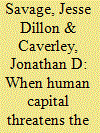

|
|
|
|
|
| Summary/Abstract |
How does aid in the form of training influence foreign militaries’ relationship to domestic politics? The United States has trained tens of thousands of officers in foreign militaries with the goals of increasing its security and instilling respect for human rights, democracy, and civilian control. We argue that training increases the military’s power relative to the regime in a way that other forms of military assistance do not. While other forms of military assistance are somewhat fungible, allowing the regime to shift resources towards coup-proofing, human capital is a resource vested solely in the military. Training thus alters the balance of power between the military and the regime resulting in greater coup propensity. Using data from 189 countries from 1970 to 2009 we show that greater numbers of military officers trained by the US International Military Education and Training (IMET) and Countering Terrorism Fellowship (CTFP) programs increases the probability of a military coup.
|
|
|
|
|
|
|
|
|
|
|
|
|
|
|
|
| 10 |
ID:
144111
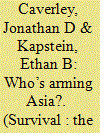

|
|
|
|
|
| Summary/Abstract |
In the international arms trade, as in any industry, market share is power. But unlike most other products, when it comes to the sale of weapons, power is not limited to economics. Arms exports not only benefit producers (and, sometimes, defence ministries) financially; they also cement relationships (often asymmetric, and occasionally coercive) between seller and client.
|
|
|
|
|
|
|
|
|
|
|
|
|
|
|
|
|
|
|
|
|